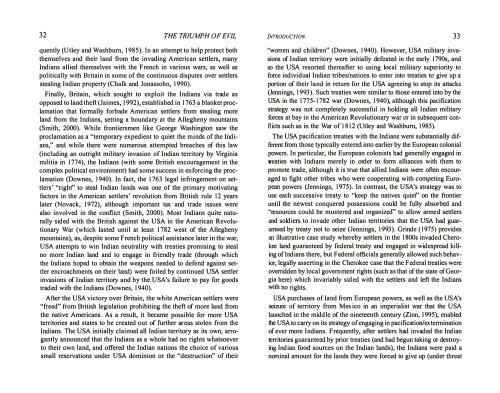austin-murphy-the-triumph-of-evil
austin-murphy-the-triumph-of-evil
austin-murphy-the-triumph-of-evil
Create successful ePaper yourself
Turn your PDF publications into a flip-book with our unique Google optimized e-Paper software.
32 THE TRIUMPH OF EVIL<br />
quently (Utley and Washburn, 1985). In an attempt to help protect both<br />
<strong>the</strong>mselves and <strong>the</strong>ir land from <strong>the</strong> invading American settlers, many<br />
Indians allied <strong>the</strong>mselves with <strong>the</strong> French in various wars, as well as<br />
politically with Britain in some <strong>of</strong> <strong>the</strong> continuous disputes over settlers<br />
stealing Indian property (Chalk and Jonassohn, 1990).<br />
Finally, Britain, which sought to exploit <strong>the</strong> Indians via trade as<br />
opposed to land <strong>the</strong>ft (Jaimes, 1992), established in 1763 a blanket proclamation<br />
that formally forbade American settlers from stealing more<br />
land from <strong>the</strong> Indians, setting a boundary at <strong>the</strong> Allegheny mountains<br />
(Smith, 2000). While frontiersmen like George Washington saw <strong>the</strong><br />
proclamation as a "temporary expedient to quiet <strong>the</strong> minds <strong>of</strong> <strong>the</strong> Indians,"<br />
and while <strong>the</strong>re were numerous attempted breaches <strong>of</strong> this law<br />
(including an outright military invasion <strong>of</strong> Indian territory by Virginia<br />
militia in 1774), <strong>the</strong> Indians (with some British encouragement in <strong>the</strong><br />
complex political environment) had some success in en forcing <strong>the</strong> proc <br />
lamation (Downes, 1940). In fact, <strong>the</strong> 1763 legal in fringement on settlers<br />
' "right" to steal Indian lands was one <strong>of</strong> <strong>the</strong> primary motivating<br />
factors in <strong>the</strong> American settlers' revolution from British rule 12 years<br />
later (Novack, 1972), although important tax and trade issues were<br />
also involved in <strong>the</strong> conflict (Smith, 2000). Most Indians quite naturally<br />
sided with <strong>the</strong> British against <strong>the</strong> USA in <strong>the</strong> American Revolutionary<br />
War (which lasted until at least 1782 west <strong>of</strong> <strong>the</strong> Allegheny<br />
mountains), as, despite some French political assistance later in <strong>the</strong> war,<br />
USA attempts to win Indian neutrality with treaties promising to steal<br />
no more Indian land and to engage in friendly trade (through which<br />
<strong>the</strong> Indians hoped to obtain <strong>the</strong> weapons needed to de fend against settler<br />
encroachments. on <strong>the</strong>ir land) were foiled by continued USA settler<br />
invasions <strong>of</strong> Indian territory and by <strong>the</strong> USA's failure to pay for goods<br />
traded with <strong>the</strong> Indians (Downes, 1940).<br />
After <strong>the</strong> USA victory over Britain, <strong>the</strong> white American settlers were<br />
"freed" from British legislation prohibiting <strong>the</strong> <strong>the</strong>ft <strong>of</strong> more land from<br />
<strong>the</strong> native Americans. As a result, it became possible for more USA<br />
territories and states to be created out <strong>of</strong> fur<strong>the</strong>r areas stolen from <strong>the</strong><br />
Indians. The USA initially claimed all Indian territory as its own, arrogantly<br />
announced that <strong>the</strong> Indians as a whole had no rights whatsoever<br />
to <strong>the</strong>ir own land, and <strong>of</strong>fered <strong>the</strong> Indian nations <strong>the</strong> choice <strong>of</strong> various<br />
small reservations under USA dominion or <strong>the</strong> "destruction" <strong>of</strong> <strong>the</strong>ir<br />
/NTRODUCT/ON 33<br />
''women and children" (Downes, 1940). However, USA military invasions<br />
<strong>of</strong> Indian territory were initially de feated in <strong>the</strong> early 1790s, and<br />
so <strong>the</strong> USA resorted <strong>the</strong>reafter to using local military superiority to<br />
force individual Indian tribes/nations to enter into treaties to· give up a<br />
portion <strong>of</strong> <strong>the</strong>ir land in return for <strong>the</strong> USA agreeing to stop its attacks<br />
(Jennings, 1993). Such treaties were similar to those entered into by <strong>the</strong><br />
USA in <strong>the</strong> 1775- 1782 war (Downes, 1940), although this pacification<br />
strategy was not completely successful in holding all Indian military<br />
forces at bay in <strong>the</strong> American Revolutionary war or in subsequent conflicts<br />
such as in <strong>the</strong> War <strong>of</strong> 18 12 (Utley and Washburn, 1985).<br />
The USA pacification treaties with <strong>the</strong> Indians were substantially different<br />
from those typically entered into earlier by <strong>the</strong> European colonial<br />
powers. In particular, <strong>the</strong> European colonists had generally engaged in<br />
treaties with Indians merely in order to form alliances with <strong>the</strong>m to<br />
promote trade, although it is true that allied Indians were <strong>of</strong>ten encouraged<br />
to fight o<strong>the</strong>r tribes who were cooperating with competing European<br />
powers (Jennings, 1975). In contrast, <strong>the</strong> USA's strategy was to<br />
use each successive treaty to "keep <strong>the</strong> natives quiet" on <strong>the</strong> frontier<br />
until <strong>the</strong> newest conquered possessions could be fully absorbed and<br />
"resources could be mustered and organized" to allow armed settlers<br />
and soldiers to invade o<strong>the</strong>r Indian territories that <strong>the</strong> USA had guaranteed<br />
by treaty not to seize (Jennings, 1993). Grinde (1975) provides<br />
an illustrative case study whereby settlers in <strong>the</strong> 1800s invaded Cherokee<br />
land guaranteed by federal treaty and engaged in widespread killing<br />
<strong>of</strong> lndians <strong>the</strong>re, but Federal <strong>of</strong>ficials generally allowed such behavior,<br />
legally asserting in <strong>the</strong> Cherokee case that <strong>the</strong> Federal treaties were<br />
overridden by local government rights (such as that <strong>of</strong> <strong>the</strong> state <strong>of</strong> Georgia<br />
here) which invariably sided with <strong>the</strong> settlers and left <strong>the</strong> Indians<br />
with no rights.<br />
USA purchases <strong>of</strong> land from European powers, as well as <strong>the</strong> USA's<br />
seizure <strong>of</strong> territory from Mexico in an imperialist war that <strong>the</strong> USA<br />
launched in <strong>the</strong> middle <strong>of</strong> <strong>the</strong> nineteenth century (Zinn, 1995), enabled<br />
<strong>the</strong> USA to carry on its strategy <strong>of</strong> engaging in pacification/extermination<br />
<strong>of</strong> ever more Indians. Frequently, after settlers had invaded <strong>the</strong> Indian<br />
territories guaranteed by prior treaties (and had begun taking or destroying<br />
Indian food sources on <strong>the</strong> Indian lands), <strong>the</strong> Indians were paid a<br />
nominal amount for <strong>the</strong> lands <strong>the</strong>y were forced to give up (under threat


